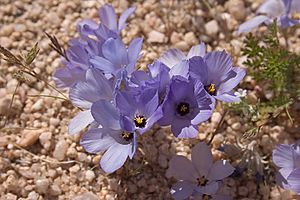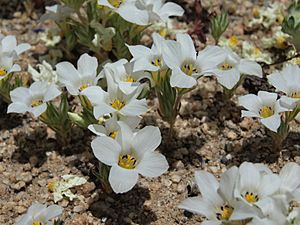Sandblossoms facts for kids
Quick facts for kids Sandblossoms |
|
|---|---|
 |
|
| Scientific classification | |
| Genus: |
Linanthus
|
| Species: |
parryae
|
The Linanthus parryae is a beautiful flowering plant. It is often called sandblossoms because it grows in sandy places. This plant belongs to the phlox family. You can only find it in California, USA. It grows in different sandy areas, from the Central Valley to the Sierra Nevada foothills and the Mojave Desert.
Contents
Meet the Sandblossom Plant
This plant is a small annual herb. This means it grows from a seed, flowers, makes new seeds, and then dies, all within one year. Its stems are very short, only a few centimeters tall. The plant has hairy leaves that look like needles.
What Does It Look Like?
The flowers of the sandblossom plant are shaped like a funnel. They are about one centimeter wide. Often, the flowers seem to sit right on the ground. They are tucked in among the plant's leaves.
How Sandblossoms Grow and Reproduce
Sandblossom seeds start to grow after winter rains. This usually happens in January or February. The plants then flower in April. They drop their new seeds in May or June. The seeds spread naturally, often just falling to the ground. These seeds can stay alive for at least seven years. If there isn't enough rain, the seeds will not grow that year. They wait for better conditions.
Why Are There Two Flower Colors?
Sandblossom flowers can be either white or blue. A single gene mainly controls their color. The gene for white flowers is recessive. This means you need two copies of it for the flower to be white. The gene for blue flowers is dominant. So, even one copy of it can make the flower blue.
Most groups of these plants have mostly white flowers. Some groups have mainly blue flowers. Other groups have a mix of both blue and white flowers. The number of each color usually stays the same over time. In some places, you can see a sudden change from blue to white flowers. This interesting feature makes the sandblossom a model organism. Scientists study it to learn about genetic variation, which is how traits differ among living things.
Scientists and the Sandblossom
For many years, geneticists (scientists who study genes) and botanists (scientists who study plants) have studied sandblossom plants. Famous scientists like Sewall Wright, Carl Epling, Harlan Lewis, and T. G. Dobzhansky have looked at these flowers. They wanted to find out why the flower colors vary so much. This variation is called polymorphism.
Flower color numbers can change for many reasons. Two main reasons are genetic drift and natural selection. Genetic drift is when gene numbers change randomly, especially in small groups. Natural selection is when nature "chooses" traits that help a plant survive better.
Wright used information from Epling and Dobzhansky to develop his theories. These theories, like "isolation by distance" and "Shifting Balance," explain how genetic drift affects plants. More recent studies also show that natural selection plays a big part in how flower colors change.


